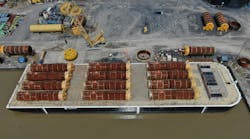Having been the first to install and operate a smart well control system, Saga Petroleum, operating the Snorre license, has now initiated a testing and qualification program aimed at improving the long-term reliability of such equipment.
The three-month program which was due to begin in July using a specially built test cell at Rogaland Research (RF) in Stavanger involves accelerated testing of equipment in order to identify failures which might be expected to occur only after years of functioning.
It was in August 1997 that Saga brought the first smart system into operation on behalf of its partners, Amerada Hess, Elf, Enterprise, Esso, Idemitsu, Norsk Hydro, RWE-DEA, and Statoil.
The system, PES' SCRAMS (surface controlled reservoir analysis and management system), was installed on a new production well on the Snorre tension-leg platform and worked well for about four months. "During this period, the optimization of production we achieved was very good," said Are Bjørnsgaard, Staff Engineer in Saga's well technology department. "The investment paid off and overall it was a very positive experience."
System modification
After four months, however, two equipment failures brought the system to a halt as a result of fluid ingress into the equipment's electronic parts and a valve malfunction. A 20-30 day round trip to pull, repair and reinstall the equipment was not justified, so the equipment remains downhole while the well now produces under its own steam.
Saga and PES worked together to diagnose the cause of the failures and modify the system, and there have been no further failures in this respect in SCRAMS systems subsequently delivered to other customers. But failures have occurred due to other causes, prompting Saga to tackle the issue of reliability before it makes any further installations.
The test program at RF will take place in a specially built test cell known as the DIACS (downhole instrumentation and control systems) facility. Here, typical downhole conditions including high temperatures and pressures and an erosive environment can be reproduced. Over three months, the equipment will be subjected to the stresses and strain which it would be expected to withstand in a period of several years in a downhole situation.
System design
Together with Norsk Hydro and Statoil - both companies also are using SCRAMS systems - and the Sintef research institute, Saga is involved in a separate initiative to prepare specifications for the development and manufacture of smart downhole equipment so that operator requirements are fully taken on board by suppliers during system design and pro duction. The companies recognize that a dialogue with suppliers is necessary if they are to achieve their objectives, and in mid-year, a draft form of the specification document was circulated for suppliers' comments.
"This is an iterative process which will be repeated until we arrive at a document which sets out the functional specifications for these systems, together with agreed design, testing, and quality control requirements," said Bjørnsgaard.
By making a common approach to the supply industry, the three Norwegian companies aim to get a higher focus from suppliers on what they want from smart well technology. "Reservoir optimization problems are common, and the type of requirements we have as operators are pretty common, so it's logical that we should cooperate on this," Bjørnsgaard says.
The systematic approach should also help to ensure improved reliability in smart well systems. As new prototypes are developed, the intention will be to run them through the DIACS testing facility at RF.
The potential advantages for Saga of a reliable smart well system are considerable, especially in the case of a heavily faulted, complex reservoir such as that at Snorre. "There are two main benefits, as we see it," says Bjørnsgaard. "If you can monitor and control the different zones in a well, you can reduce the number of mechanical interventions, which are very costly. You can also reduce the lead time from discovering a change in the production behavior to taking action. The end result is that you produce additional amounts of oil, which of course translates into additional income."
The company is preparing to use smart well systems on the new Snorre B platform, which is due to come into operation in 2001. According to the plan for development and operation, smart systems will be installed on 17 of the 27 wells planned for Snorre B, including seven production and 10 injection wells. "Controlling injection into the relevant zones can be as valuable as controlling production flow," Bjørnsgaard says.
Before these plans are implemented, however, Saga wants to see progress achieved in the two research and development projects. "It all depends on how mature the technology is, so these plans could change." The same proviso also applies to the Snorre tension-leg platform, where current plans call for the eventual installation of systems on two wells a year.
The company's Tordis and Vigdis fields, which produce through subsea facilities, would also benefit from smart downhole technology. "Unfortunately, without very high investments and efforts, we're not able to modify the subsea infrastructure to handle the smart well system," Bjørnsgaard says. "It's partly a problem of physical access to the wells, and partly one of integrating the smart well control system with the existing control system."




